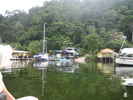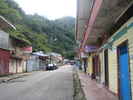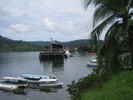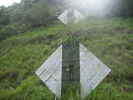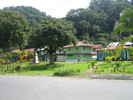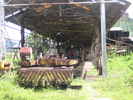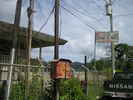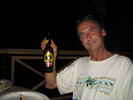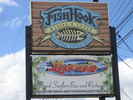Bahia Golfito and Tierra y Mar MarinaAs mentioned on our previous page, we had no problem making the channel into Bahia Golfito. After checking in with the Naval Base on Channel 16, giving them our vessel name, registration number, Costa Rican Zarpe number, and the skipper's passport number, we made the turn and took a mooring at Tierra y Mar (Land and Sea) marina. We chose Tierra y Mar rather than the alternatives Banana Bay or FishHook, as the prices were much more reasonable. Banana Bay wanted $1.50/ft/day for a slip and $20 for a mooring and Fishhook was slightly more expensive. At the time of this writing, Tierra y Mar was asking $8/day for a mooring which includes a nice little club house, free wifi, nice clean showers, $1 beers and soft drinks, a great lending library, lavanderia, sweet dogs and a cat, and perhaps most importantly the 14 yr local knowledge and expertise of Tim and Katie,the proprietors. We spent 9 nights in Bahia Golfito. At first, when we arrived with KETCHIN UP, we were a little disappointed with the town. In the usual afternoon rain, when we went ashore, it seemed a bit dirty and seedy, and the residents glum. However, after we had been there a few days it started to grow on us, and by the time we left we had grown fond of the place. We had the usual boat chores to do. Tierra y Mar offered a laundry service, so as we had a slew of dirty clothes, that was one of the first things that we did. We also did a lot of provisioning, stopping at one of the three grocery stores on the way back to the boat whenever we happened to be walking by. It takes a lot to stock the boat fully up carrying it all by hand/backpacks, especially the liquids like fruit juice, soft drinks and beer, so I would say we made about 5 trips to the grocery stores during our stay there. On Sunday afternoon, we invited KETCHIN UP and the kids up to the TV/rec room upstairs at the marina to watch movies and eat popcorn. With a huge bag full of popcorn and butter, we had a delightful time laughing at "Blades of Glory" with Noel, Ashley, and the boys. Several other cruisers dropped by during the day to partake in the movies and snacks. On about our third day, Monday, the Perko switch I had put in about 2 weeks previously in Puntarenas, that connects the inverter to the battery bank, melted and ceased to function. I took it apart (broke it apart) and could clearly see where the contacts had been impeded by melted plastic. The problem appears to be that when we run both the generator and battery charger, a relatively large amount of current, 100 to 120 amps, is pushed thru the switch and the attached wiring into the batteries. Since the switch is rated at 250 amps continuous and 350 amps intermittent, I felt that the problem must lay elsewhere. Several short pieces of wire, leading from the switch to a 250 amp fuse, and from the fuse to the battery bank were getting very hot (enough to melt the solder in their connections) after running the battery charger for a while. My guess is that the wire was actually causing the heat that melted the switch. These wires were "2 gauge", about 1/2" in diameter, with about 1/4" width of copper wire. The usual solution in this kind of overheating is to switch to the next larger gauge of wire, in this case "2/0 gauge", which is about 3/4" in diameter with about 1/2" width of copper wire. Golfito turned out to be a good place to solve this problem. A short 1/4 mile walk took me to a hardware store where I got some thicker battery cable and connectors, then to the Borbon Chandlery for a new switch and a spare, finally stopping at a machine shop located right next to our marina where I had them solder the connectors onto the wire. Since the switch is of the A/B/All type, which allows two battery banks to be hooked up, I fastened the old 2 gauge wire to one of the set of contacts then doubled it up with the new 2/0 wire to the other set of contacts. Thus, when the switch is in the ALL position, the current and heat is spread across two separate sets of wires and switch contacts. This mitigated the problem somewhat. After running the generator and seeing 110 amps put into the battery bank for about an hour, the wires and switch were warm, but not dangerously hot. To further mitigate the problem, I scanned the Inverter/Charger documentation and found a switch setting that would limit the current put out to 85-90 amps. Now when we run the generator it gets warm but not hot, so I'm hoping I don't have to revisit that situation again. Apart from our boat chores, we did go into town quite a few times exploring, and as I said, on provisioning and other such runs. One we went to the airport and the attached "Duty Free Zone". When I got there, I got to experience a strange set of rules and a bit of a mordida (petty extortion) attempt. The duty free zone requires that foreigners, like me, present their passports and get a document to enter the shopping zone. When I got the document, a roving customs officer (rent-a-cop) told me it was not for the day I was there (Sunday) but was only good for the following day, Monday. I was really surprised at this and asked several times, verifying, in my halting Spanish, that the permit was not good for today, but that I needed to come back manana (tomorrow). After about 10 minutes of this conversation, the "customs agent" conveyed to me that he could, if I really wanted, accompany me into the duty free zone for limited shopping this very day! I was interested in restocking our tequila supply and thought it might be cheaper in the zone than at the local grocery stores.
So the guard took me around to the liquor stores, which were all very sparsely supplied, albeit with top shelf liquor. I found some Don Julio tequila at a price of about $20 for 1/2 litre, about $2 cheaper than the grocery store. When I inquired about purchasing it, I was only a little surprised when the agent told me that although I could not "officially" buy the liquor until the next day, for a small fee, he could arrange for me to purchase it that day. When I asked him how much his commission would be, he told me $8. Duh! It was kind of a rip, from my perspective, so I decided at that point to just leave the duty free zone and head back to the boat, which I did. I caught a return cab, and on the way stopped at a grocery store and bought more beer and provisions, including a bottle of tequila (a full litre of Jose Cuervo, for about $25) and returned to the boat. We kept pretty busy in Golfito. Tuesday, June 10th was my birthday so we went to dinner at the FishHook restaurant. Although their slips are expensive, the restaurant was pretty reasonable with $8-12 entrees. We had a wonderful dinner looking out over the bay and chatting with some other folks, Bryan and Lisa, who had come to Golfito from N Carolina, driving overland after flying to San Jose. In fact, we had dinner at the FishHook three times overall during our nine day stay in Golfito. |




